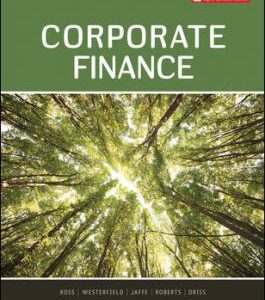No products in the cart.
Corporate Finance
 Loading...
Loading...
Fundamentals of Corporate Finance, 7th Canadian Edition A. Brealey, C. Myers, J. Marcus, Mitra, Gajurel Instructor Solution Manual
Fundamentals of Corporate Finance, 7th Canadian Edition A. Brealey, C. Myers, J. Marcus, Mitra, Gajurel 2020 Instructor Solution Manual
Fundamentals of Corporate Finance
( Instructor Solution Manual)
Fundamentals of Corporate Finance, 7th Canadian Edition A. Brealey, C. Myers, J. Marcus, Mitra, Gajurel 2020 Instructor Solution Manual
Edition: 7th Canadian
Author Name: A. Brealey, C. Myers, J. Marcus, Mitra, Gajurel
contact:
Whatsapp +1 (949) 734-4773
for the Facebook page click here
for more books for ( Test Bank and Solution Manual) click here
sample free
Chapter 01
 Loading...
Loading...
$39.00 $50.00
Fundamentals of Corporate Finance, 7th Canadian Edition A. Brealey, C. Myers, J. Marcus, Mitra, Gajurel 2020 Instructor Solution Manual
Fundamentals of Corporate Finance
( Instructor Solution Manual)
Fundamentals of Corporate Finance, 7th Canadian Edition A. Brealey, C. Myers, J. Marcus, Mitra, Gajurel 2020 Instructor Solution Manual
Edition: 7th Canadian
Author Name: A. Brealey, C. Myers, J. Marcus, Mitra, Gajurel
contact:
Whatsapp +1 (949) 734-4773
for the Facebook page click here
for more books for ( Test Bank and Solution Manual) click here
sample free
Chapter 01
Instructor Solution Manual
Brealey 7CE
Solutions to Chapter 1
- real
executive airplanes
brand names
financial
stocks
investment
capital budgeting
financing
- A firm might cut its labour force dramatically which could reduce immediate expenses and increase profits in the short term. Over the long term, however, the firm might not be able to serve its customers properly or it might alienate its remaining workers; if so, future profits will decrease, and the stock price will decrease in anticipation of these problems.
The moral of this examples is that, because stock prices reflect present and future profitability, the firm should not necessarily sacrifice future prospects for short-term gains.
- The key advantage of separating ownership and management in a large corporation is that it gives the corporation permanence. The corporation continues to exist if managers are replaced or if stockholders sell their ownership interests to other investors. The corporation’s permanence is an essential characteristic in allowing corporations to obtain the large amounts of financing required by many business entities.
Both public and private corporations are distinct legal entities, separate from its owners (ie., its shareholders). The key difference between public and private corporations is the rules governing the sale of their common shares. The common shares of a public corporation are listed for trading on a stock exchange and investors can freely buy and sell the corporation’s shares at the current stock price. The common shares of a private corporation are not listed for trading on a stock exchange. Shareholders of private corporations must negotiate directly with potential buyers and are subject to resale restrictions.
You can learn to identify the risks associated with investing in private companies by going to Ontario Securities Commission’s website at:
http://www.osc.gov.on.ca/en/Investors_cbyi_index.htm
- A sole proprietorship is easy to set up with a minimum of legal work. The business itself is not taxed. For tax purposes, the income of the proprietorship is treated as the income of the proprietor. The main disadvantages of a proprietorship are the proprietor’s unlimited liability for the debts of the firm, and difficulty in raising large amounts of financing as the business grows.
A partnership has the same tax advantage as the proprietorship. The partnership per se does not pay taxes. The partnership files a tax return, but all of the partnership income is allocated to the partners and treated as personal income. Also, it is fairly easy to set up a partnership. Because there can be many partners, a partnership can raise capital more easily than a proprietorship. However, like sole proprietors, general partners have unlimited liability for the debts of the firm. In fact, each partner has unlimited liability for all the business’ debts, not just his or her share.
Corporate organization has the advantage of limited liability. Its owners, the shareholders, are not personally responsible for the debts of the corporation. It also allows for separation of ownership and management, since shares in the firm can be traded without changing management. A public corporation has the added advantage of easier access to equity financing because its shares are traded in public stock markets. The major disadvantage of corporate organization is the double taxation of income. Corporations pay taxes on their income, and that income is taxed again when it is passed through to shareholders in the form of dividends. Another disadvantage of corporate organization is the extra time and cost required in order to manage a corporation’s legal affairs. These costs arise because the corporation must be chartered and is considered a distinct legal entity. Such administrative costs are significant only for small corporations, however. Furthermore, public corporations must provide investors with detailed financial information in their annual reports and inform investors about significant events. Disclosure takes time and resources and may also be costly in the sense that competitor firms become aware of inside information that the corporation may not necessarily want competitors to be aware of.
LLP’s may be considered to be hybrid organizations to the extent that while individual partners have unlimited liability, they are not liable for the actions of their partners.
- Double taxation means that a corporation’s income is taxed first at the hands of the corporation at the corporate tax rate, and then, when the income is distributed to shareholders as dividends, the income is taxed again at the hands of shareholders at the shareholder’s personal tax rate.
- a, c, d.



 Check the sample in the description
Check the sample in the description


There are no reviews yet.